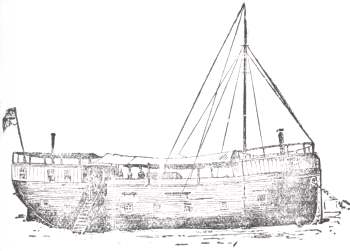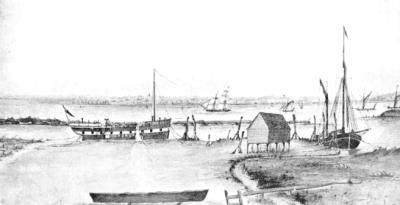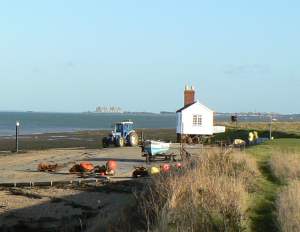Blackwater Watch Vessel & Bradwell Cutter
 The
Watch Vessel at Stansgate believed to be the Frolic.
The
Watch Vessel at Stansgate believed to be the Frolic.
The River Blackwater was as
much of a problem for the Coastguard to deter smuggling as the
Rivers Crouch and Roach to the south.
Instead of a network of Watch
Vessels in the Crouch. Roach and Thames, the Blackwater Coastline
was only protected by Watch vessel at Stansgate and a Revenue
Cutter based at Bradwell on Sea.
The cutters were important to
the Revenue men as they were small but fast and well armed and so
were able to patrol at sea and surprise the smugglers when they were
making land or floating the cargo.
In 1794 the Fly was the
excise cutter based at Bradwell when it was able to catch the crew
of the Ox red handed heading for Rowhedge on the River Colne with
300 tubs of brandy and geneva aboard.
In 1818 The rattlesnake was
transferred to Bradwell from Blackmore Haven in Sussex only to be
replaced in 1820 by the New Order although her commander Richard
Gowland stayed in charge of the new vessel.
New Order was in turn
replaced by the 240 to brigantine Richmond although this
vessel was in poor condition and became the Watch Vessel 4 at
Stansgate.
The
revenue cutter moored at Bradwell Quay in 1856 could well have been
the Richmond

In its turn the Richmond
deteriorated and was replaced in 1865 by the Frolic.
Like all watch vessels The
Frolic provided accommodation for the Chief Coastguard, four men and
their wives and families and an active base.
Being based at Stansgate
several miles from the small village of Steeple the men and their
families must have felt quite isolated while at least the Bradwell
Coastguards lived in a busy community.
Given the crowded nature and
damp living conditions illness could sweep through the vessels as
was the case in 1839 when tragedy struck Lt Carr who was Commanding
Officer of Bradwell Coastguards. On 1st February his 6 month old
daughter Margaret died, on the 3rd February his 6 year old daughter
Caroline and then on 7th February his 2 year old daughter Mary.
The life of a Coastguard was
boring, sometimes difficult and at times dangerous.
In June 1896 Coastguard James
West went to the Sun and Anchor Pub in his off duty time and enjoyed
a bit too much of Landlord, Christopher Whipps, ale. Firstly he
propositioned a young girl only to be rebuffed by her outraged
father then he was very noise and used the most filthy language. On
leaving the pub he continued his drunken behaviour on his way back
to the watch vessel. This time he upset reputable local farmer
Robert Attenborough who complained of his behaviour. On 27th
June 1898 he pleaded guilty and was fined 10 shillings with 11
shillings costs.
Shortly after this
transgression the more dangerous side of life as a coastguard was
highlighted. In September 1896 Coastguard James Collier aged 23
drowned when his small boat capsised after he had inspected the
ketch Emily Lloyd .
In October 1906 the Watch
Vessel was decommissioned and the men posted to other stations
causing upset to the villagers of Steeple due to the loss of trade..
Customs men on the Watch
Vessels or the land stations could only watch or mount land patrols
which given the tacit support by the local residents for the
smugglers usually proved a failure.

All
that remains of the Stansgate Coastguard's is the white building now
used as a store that was formerly the washroom for the Coastguard
and their families




